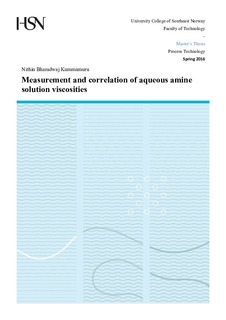| dc.description.abstract | The viscosities of amines are important in designing equipment for Carbon dioxide (CO2) capture as it affects heat transfer coefficient, pressure drop in heat exchangers and piping system respectively. Reliable viscosity data from binary, tertiary, and quaternary systems are necessary for the development of kinetic and equilibrium models. This work discusses viscosity of selected alkanolamine systems with the aim of providing new and complementary experimental data.
Viscosities were measured by using a rheometer with a double gap measuring system, and all the measurements were performed at a constant shear rate at 4 bar throughout different temperatures. The first part of this thesis covers the viscosity for the binary system of Monoethanolamine (MEA) and 3-Amino-1-propanol (3A1P) aqueous solutions at high concentrations and ternary system of 2-Amino-2-methyl-1-propanol (AMP) + Piperazine (PZ) + Water for mass fractions 0.2/0.05, 0.3/0.05, 0.4/0.05 AMP/PZ. All the measurements were performed at temperatures between 298.15 K and 373.15 K. The second part of this thesis covers the viscosities of 50-80 Wt % MEA CO2 loaded solutions and 30, 50 Wt % 3A1P CO2 loaded solutions with five different CO2 loadings from temperatures 298.15 K to 373.15 K.
All the measured viscosities were compared and found to agree with literature data to the extent available. Viscosities of these amine solutions were found to decrease with increase in temperature and increase with increase in CO2 loadings and respective amine concentrations. In this work, data representation was also investigated by five different models for aqueous MEA, and 3A1P solutions. Two different models were used to correlate viscosity data for ternary system AMP + PZ + water. The experimental viscosities for CO2 loaded MEA and 3A1P solutions were regressed by using two models. These are discussed in detail in the subsequent chapters. The experimental viscosities showed good agreement with regressed values of viscosities from various models. The uncertainties in measurements are also discussed. | nb_NO |
